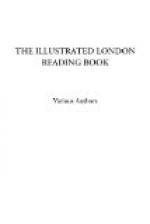A Nightingale that all day
long
Had cheer’d the village
with his song,
Nor yet at eve his note suspended,
Nor yet when even-tide was
ended—
Began to feel, as well he
might,
The keen demands of appetite:
When, looking eagerly around,
He spied, far off upon the
ground,
A something shining in the
dark,
And knew the glowworm by his
spark:
So stooping down from hawthorn
top,
He thought to put him in his
crop.
The worm, aware of his intent,
Harangued him thus, right
eloquent:—
“Did you admire my lamp,”
quoth he,
“As much as I your minstrelsy,
You would abhor to do me wrong,
As much as I to spoil your
song;
For ’twas the self-same
power Divine
Taught you to sing and me
to shine,
That you with music, I with
light,
Might beautify and cheer the
night.”
The songster heard his short
oration,
And, warbling out his approbation,
Released him, as my story
tells,
And found a supper somewhere
else.
COWPER.
* * * * *
THE INVISIBLE WORLD REVEALED BY THE MICROSCOPE.
A fact not less startling than would be the realisation of the imaginings of Shakespeare and of Milton, or of the speculations of Locke and of Bacon, admits of easy demonstration, namely, that the air, the earth, and the waters teem with numberless myriads of creatures, which are as unknown and as unapproachable to the great mass of mankind, as are the inhabitants of another planet. It may, indeed, be questioned, whether, if the telescope could bring within the reach of our observation the living things that dwell in the worlds around us, life would be there displayed in forms more diversified, in organisms more marvellous, under conditions more unlike those in which animal existence appears to our unassisted senses, than may be discovered in the leaves of every forest, in the flowers of every garden, and in the waters of every rivulet, by that noblest instrument of natural philosophy, the Microscope.
[Illustration: LARVA OF THE COMMON GNAT.
A. The body and head of the larva (magnified).
B. The respiratory apparatus, situated
in the tail.
C. Natural size.]
To an intelligent person, who has previously obtained a general idea of the nature of the Objects about to be submitted to his inspection, a group of living animalcules, seen under a powerful microscope for the first time, presents a scene of extraordinary interest, and never fails to call forth an expression of amazement and admiration. This statement admits of an easy illustration: for example, from some water containing aquatic plants, collected from a pond on Clapham Common, I select a small twig, to which are attached a few delicate flakes, apparently of slime or jelly; some minute fibres, standing erect here and there on the twig, are also dimly visible to the naked eye. This twig, with a drop or two of the water, we will put between two thin plates of glass, and place under the field of view of a microscope, having lenses that magnify the image of an object 200 times in linear dimensions.




